Law & Politics
Jeffrey Epstein Accuser Maria Farmer Says the New York Academy of Art Helped Enable the Disgraced Financier
The school says it will now assemble a committee to formalize how art collectors can and should interact with students.
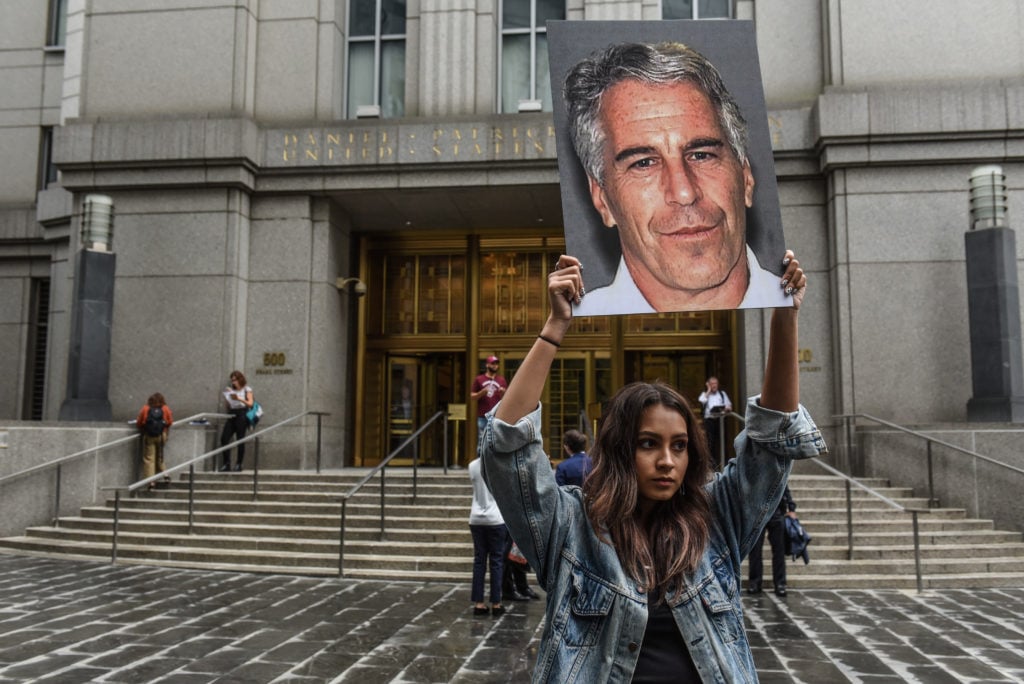
The school says it will now assemble a committee to formalize how art collectors can and should interact with students.

Rachel Corbett &
Ben Davis

As the lurid details about Jeffrey Epstein’s decades of crimes against women and girls continue to trickle out, one unexplained recurring character in the saga has been the New York Academy of Art, a private graduate school known for its emphasis on preserving the tradition of figurative art. It is where Epstein met the young woman who became one of his earliest known alleged victims. It crops up, decades later, in connection with a strange painting of Bill Clinton wearing a dress that was spotted at Epstein’s house, purchased from an academy fundraiser in 2012.
Now, in response to mounting questions about Epstein’s relationship with the school, the New York Academy of Art has promised to issue new guidelines to govern the relationships between students and collectors.
Epstein was a board member at the academy from 1987 to 1994 and a regular fixture at the school during that time, according to one former student, Maria Farmer, who has, along with her younger sister, Annie Farmer, gone on to accuse the disgraced financier of assault. (The academy originally disputed that Epstein had ever been a trustee, but later reversed itself, confirming that he was on the board for seven years.)
“Sometimes he would just come to the school and walk around and watch the artists. He was at every single event,” Farmer told artnet News. He was “often lurking around, looking at the students’ studios.”
The artist says she first met Epstein and his associate Ghislaine Maxwell at her thesis show in 1995 when the school’s then-dean of students, Eileen Guggenheim, urged her to sell them one of her paintings. (Guggenheim is now chair of the academy’s board.) The work depicted a man standing in a doorway observing a nude woman on a sofa, which was an allusion, Farmer recently told the New York Times, to Edgar Degas’s Interior (1868-69), also widely known as The Rape.
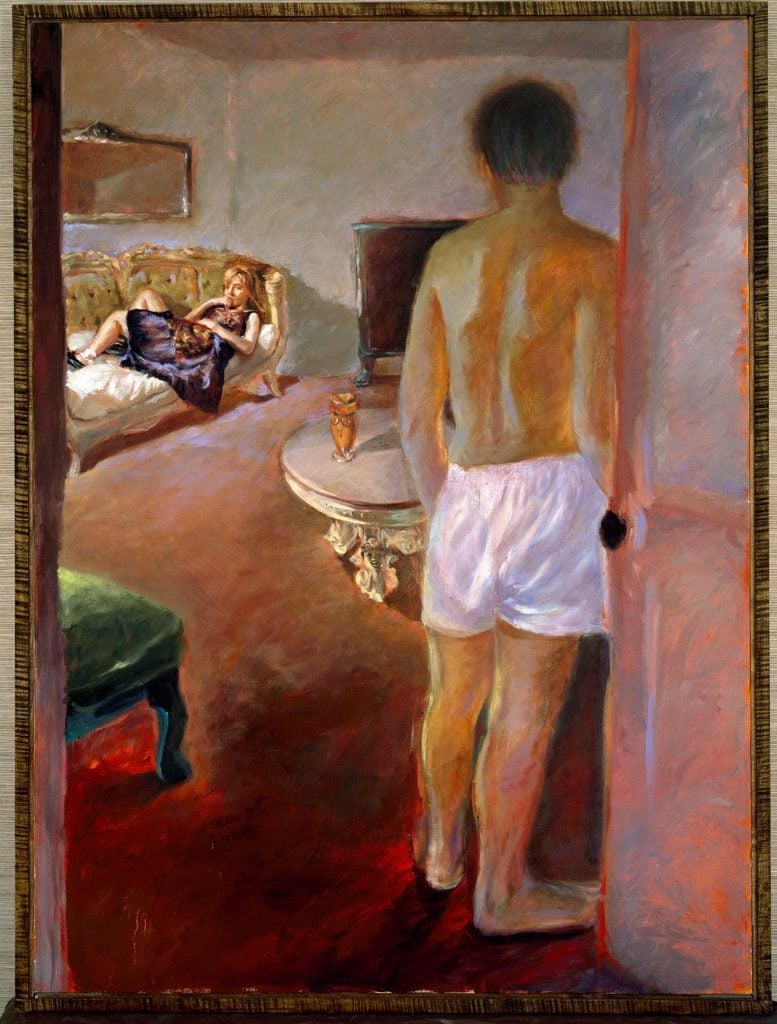
A painting by Maria Farmer that she says Epstein bought from her thesis show at the New York Academy of Art.
Farmer said she was reluctant to agree because she’d already sold the painting to a German buyer for $12,000. But Guggenheim allegedly told her, “‘You will be selling to them,'” Farmer recalled. “‘They are great benefactors of the academy and you are going to make them happy. Do you understand?'” (Guggenheim told artnet News through a spokeswoman that she does not remember this exchange.)
In an earlier court statement, she also claimed that Epstein said to her that “if I sold him one of my paintings for half price he would help me with my career.”
Farmer ultimately relented. “I was a trusting student,” she said. “Who doesn’t look up to the dean of their graduate program?” She agreed to the reduced fee of $6,000 and “embarrassingly” informed the German collector that she was mistaken and the painting had already sold.
Shortly after her graduation, in 1995, Farmer said that Guggenheim brought her on a visit to Epstein’s ranch in New Mexico. Farmer was in town to attend a post-graduate workshop at the Santa Fe Art Institute with the painter Eric Fischl; Guggenheim was there to attend the Site Santa Fe biennial. Prior to the visit with Epstein, Farmer recalled Guggenheim instructing her to “act grateful and tell him how wonderful he is,” insinuating that he was important to the academy. (Guggenheim said she does not recall this visit.)
“He was seated in this chair and he’s all flirty with me,” Farmer said, “but I thought he was married to Ghislaine.” She remembers Maxwell as a formidable woman who initially made her feel comfortable. “While we were there she literally rode up on a white horse,” Farmer added.
Once Farmer returned to New York, Epstein hired her as an art consultant. “Epstein had bad taste,” Farmer recalled, a fact that has been established in reports about the aggressively unsettling décor of Epstein’s homes, which is known to have included displays of prosthetic eyeballs, a female mannequin hanging from a chandelier, a chess set featuring the likenesses of his staff clad only in underwear, and a painting of Bill Clinton in a blue dress by another New York Academy of Art student, Petrina Ryan-Kleid. “He liked art that made people react,” Farmer added.
During her employment, she says she did manage to convince him to buy work by some artists she respected, including Chuck Bowdish and Damian Loeb. She remembers Epstein bought Loeb’s painting of a child swimsuit pageant, Little Miss Pink Tomato (1995).
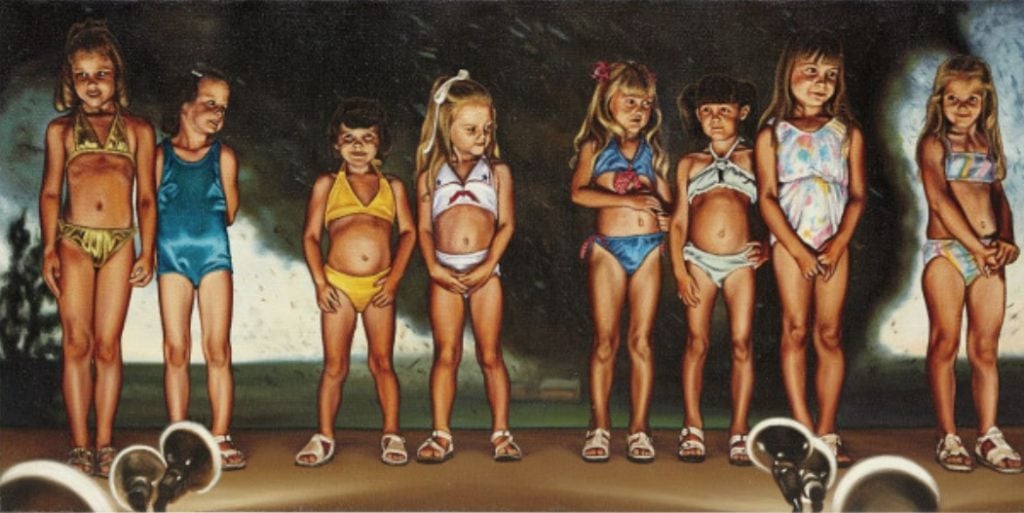
Maria Farmer says Epstein purchased this painting by Damian Loeb, Little Miss Pink Tomato (1995), at her suggestion. Courtesy of artnet.
At one point, Epstein offered to provide Farmer studio space to work on a series of paintings she’d been commissioned to produce for the set of the film As Good As It Gets. He arranged for her to travel to the Ohio mansion of his associate, clothing magnate and art collector Leslie Wexner, and his wife Abigail. While there, Farmer claims that Epstein and Maxwell sexually assaulted her.
The next morning, she says she called Eileen Guggenheim and told her what happened. “I was sobbing and said Epstein and Maxwell are sick people and I think I could have been raped,” Farmer said. In response, Guggenheim allegedly “blamed me and mocked me.” Guggenheim said she does not recall this conversation.
In a statement, the New York Academy of Art said the school is taking steps to reconsider the way art collectors interact with its students. “The New York Academy of Art is deeply shocked and saddened by what one of our graduates, Maria Farmer, went through at the hands of Jeffrey Epstein, and we are truly sorry for what happened to Maria,” a representative said in a statement. “The office of the president is establishing a committee to formalize a protocol for how art collectors can and should interact with the Academy’s student artists.”
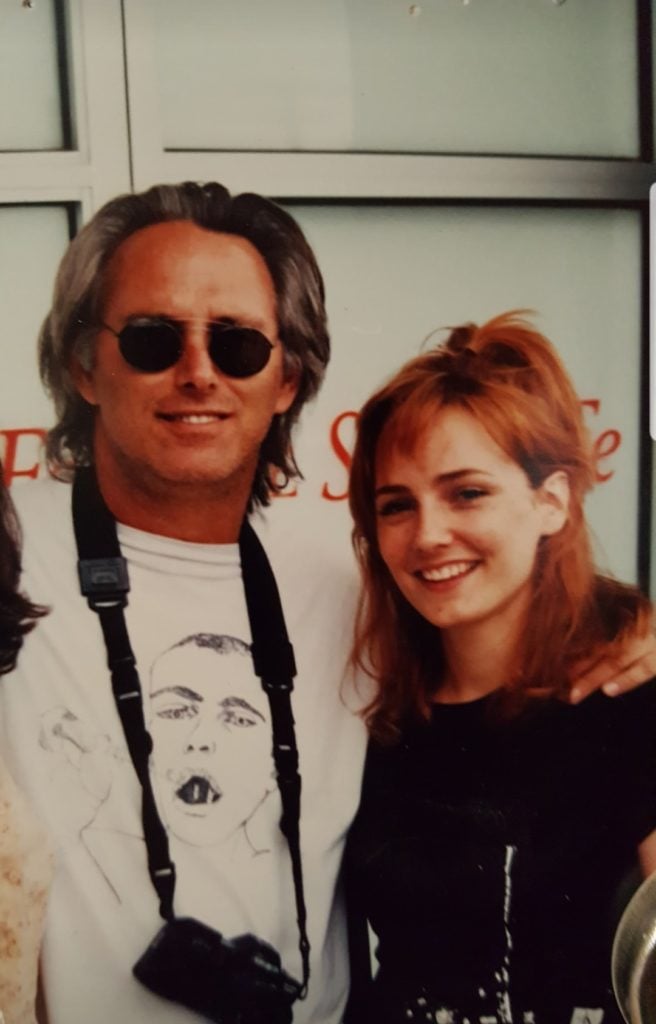
Eric Fischl and Maria Farmer in Santa Fe. Courtesy of Maria Farmer.
Epstein’s ties to the academy have been murky. In 2012, as part of what the Miami Herald described as a broader campaign to enhance his image as a philanthropist and investor, the Jeffery Epstein VI Foundation announced in a press release that it had given “crucial funding” to the academy, lauding it as “one of the few graduate art schools in the United States that focus on a purely classical approach to the visual arts.” (The previous year, his status as a “high risk” sex offender, active since 2010, had been upheld by a New York judge, meaning he was supposed to check in every 90 days with the New York Police Department.)
“Rigorous training in technique liberates the artist when approaching contemporary art,” Epstein was quoted as saying in the press release accompanying the donation. “It gives him the tools to express himself precisely. The same can be said for the scientist when approaching science.”
A representative for the school denied that there was any such donation. “Epstein’s foundation issued a press release without our knowledge or approval in 2012. We believe that this ‘funding’ referred to the purchase of tickets at the 2012 Tribeca Ball and his foundation then issued a press release claiming he was a donor to us because he bought tickets at a fundraiser.” (Epstein is known to have made various false claims about his philanthropy.)
Wexner, Epstein, and Maxwell all figure in another case that suggests the extent of ties between the the New York Academy of Art and the convicted sex criminal. In 2003, portrait painter Nelson Shanks sued all three individuals for nonpayment over a $339,900 portrait of Leslie’s wife Abigail Wexner and her four children. Shanks alleged that Epstein had commissioned the painting as a gift, using Maxwell as an agent, and that he had gone to the Wexner home to take photos as source material. Both Epstein and the Wexners found the final painting unflattering, and refused to pay.
Court papers filed in 2003 depict Epstein as having a longstanding relationship with the art academy, including working closely with students to develop commissioned artworks. “During Mr. Epstein’s affiliation with this institution, Mr. Epstein had occasion to purchase portraits from students enrolled at this institution,” Epstein’s legal filing stated. “On each such occasion, Mr. Epstein was given the opportunity to review the finished work, request revisions to the finished work and, only when Mr. Epstein was satisfied with the finished work, did Mr. Epstein pay for the portrait.”
Asked about the extent of Epstein’s contact with students, a spokesperson for the academy stated: “It is possible that he or someone in his employ purchased art or made arrangements for a commissioned work by a New York Academy of Art artist, but if there was a commissioned piece, that commission was handled directly between the artist and Epstein.”
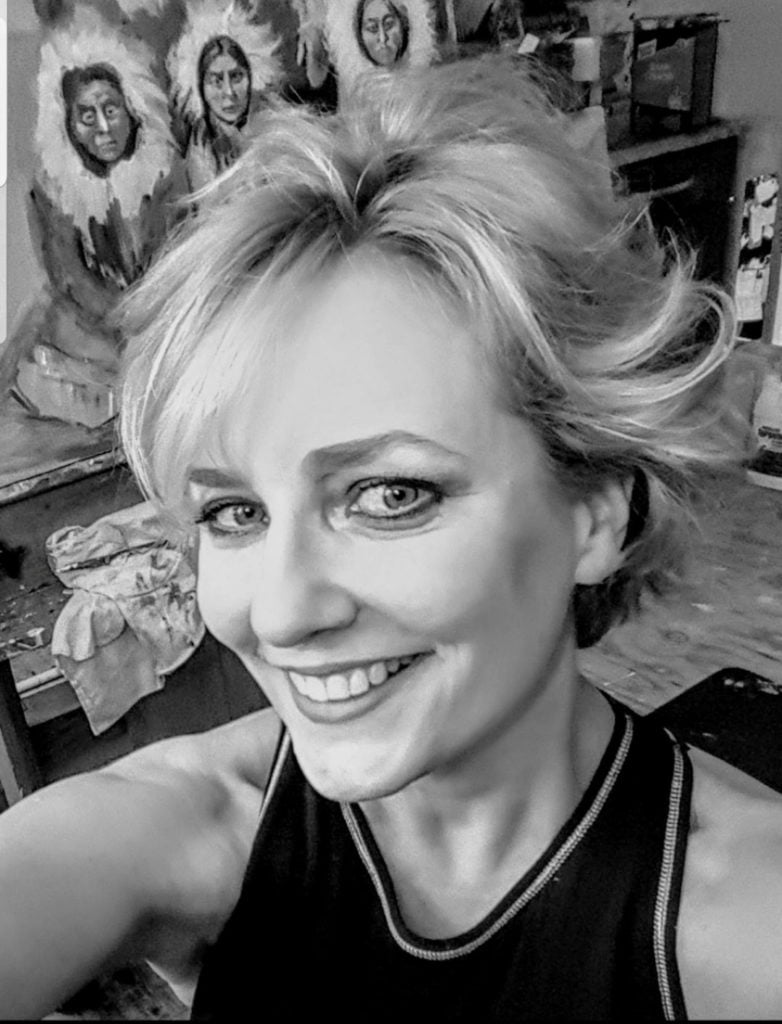
Artist Maria Farmer in her studio in 2019. Courtesy of Maria Farmer.
After their encounter in Ohio, Farmer claims that Epstein and Maxwell threatened to burn her art and destroy her career. As a result, she says, she left New York and largely gave up painting. “I was vulnerable because my career was used against me,” she said.
She has also since been diagnosed with a brain tumor and, although it has slowed her down, has vowed to return to work. Today, she’s working on a new series of portraits of Epstein’s victims. She’s planning to meet with the women for sittings and will also create a series of female figures in the form of paper dolls, representing “all the ones we don’t know about.”
Farmer said that although Epstein derailed her career, she’s resolved to have her story told. “I need it said, I want people to know about the people who really abuse artists.”
UPDATE, August 27: After publication, Eileen Guggenheim responded in an email to artnet News that she was “appalled by Maria Farmer’s traumatic experience at the hands of Jeffrey Epstein and Ghislaine Maxwell” and “deeply sympathetic to her plight.” She sent the following statement:
First, your article describes a painting that Ms. Farmer sold to Mr. Epstein in 1995, quoting Ms. Farmer as saying that I insisted she sell the work to Mr. Epstein. I have never forced an art sale by an Academy student. I do what many other board members and school administrators do—I often introduce collectors to students and encourage them to sell their work in order to help them establish their careers. This is beneficial to emerging artists.
Second, in 1995, at a post-graduate workshop in Santa Fe, your reporter states that I took Ms. Farmer to Mr. Epstein’s ranch and instructed her to ‘act grateful’ and flatter him, the insinuation being that I acted as an enabler in her relationship with Mr. Epstein in order to benefit the school. This is a serious mischaracterization. I have never been at Mr. Epstein’s home in Santa Fe and have never encouraged an emerging artist to enter into a personal relationship with a collector to advance their career.
Third, your article, in describing the time that Ms. Farmer spent in Ohio after she graduated, and while she was in the employ of Mr. Epstein, states that Ms. Farmer called me from Ohio the day after she says she was assaulted by Mr. Epstein. This is not true. Many weeks after her return from Ohio, Ms. Farmer came to see me in New York and mentioned that something untoward had happened in Ohio between her and Mr. Epstein and Ms. Maxwell. I immediately expressed my sympathies. She provided no details to suggest that there had been any physical contact or violation. Had she mentioned the word ‘rape’ to me or described any attempt at physical contact, I would have come to her aid immediately. In no way did I mock or blame her.
Finally, it is important to note that in 1996, neither I nor the New York Academy of Art administration had any knowledge of Mr. Epstein’s crimes. Had we known, we would have taken strong action.
More Trending Stories:
Jameson Green Won’t Apologize for His Confrontational Paintings. Collectors Love Him for It